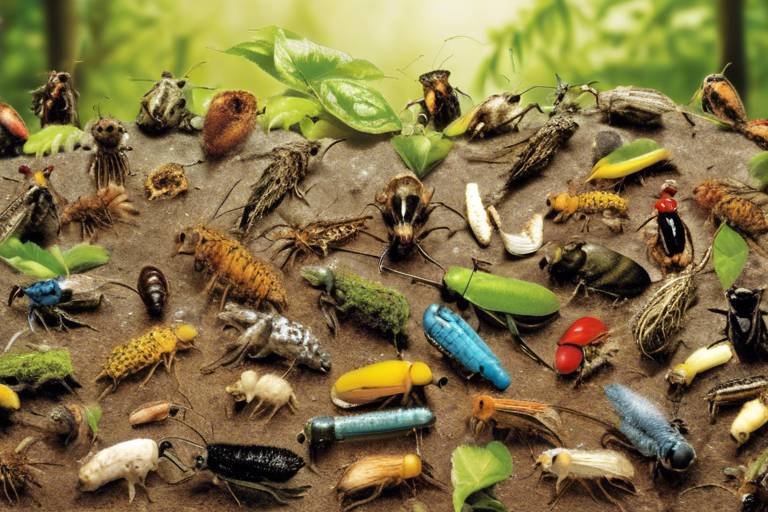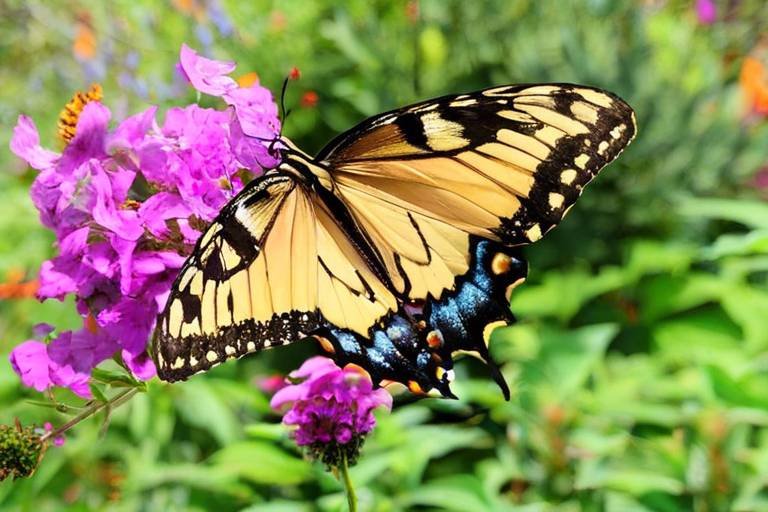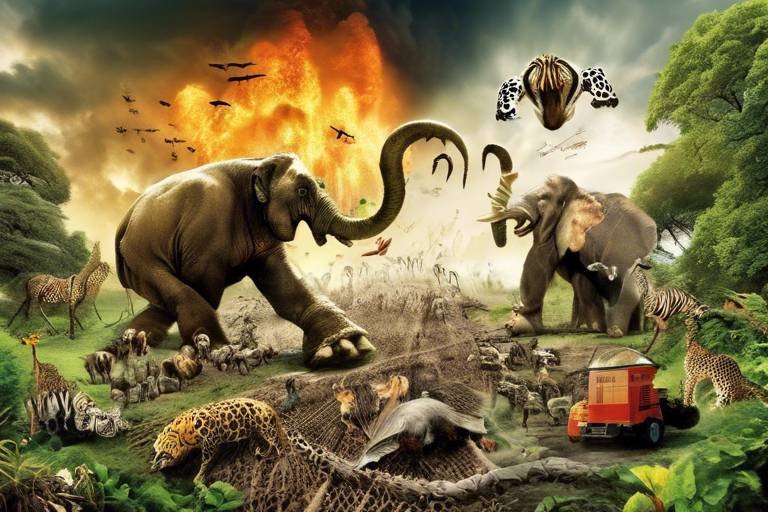Our Night Sky: The Impact of Light Pollution on Wildlife
Have you ever looked up at the night sky and marveled at the twinkling stars, only to find that they are obscured by the glow of city lights? Light pollution is not just an aesthetic issue; it poses a significant threat to wildlife, ecosystems, and even our own health. In this article, we will dive deep into the world of light pollution, exploring its sources, its detrimental effects on nocturnal animals and migratory species, and the unexpected consequences it has on human health. By understanding these impacts, we can better appreciate the importance of preserving our natural darkness for the benefit of all living organisms.
Light pollution refers to the excessive or misdirected artificial light that disrupts the natural darkness of the night sky. Its sources are numerous and often taken for granted: streetlights, billboards, buildings, and even the glow from our electronic devices. There are several types of light pollution, including skyglow, which is the brightening of the night sky over populated areas, and glare, which can cause discomfort and reduce visibility. The growing concern over light pollution stems from its profound effects on wildlife and ecosystems, which we will explore in detail.
Nocturnal animals, such as owls, bats, and various insects, rely heavily on darkness for their survival. They use the cover of night for hunting, mating, and navigating their environments. However, light pollution alters their behaviors and disrupts their natural rhythms. For instance, studies have shown that artificial lighting can lead to a decline in populations of these species, as they struggle to adapt to the changes in their habitats.
Many nocturnal species have specific mating rituals that depend on darkness. For example, certain frogs and insects use the cover of night to attract mates through calls and light displays. When artificial lighting intrudes, it can interfere with these behaviors, leading to reduced reproductive success. Imagine a male firefly flashing its light in a brightly lit area; it becomes nearly impossible for females to notice him among the competing lights. This disruption not only affects individual species but can lead to long-term declines in populations.
Light pollution can also alter the feeding habits of nocturnal predators and their prey. For instance, many nocturnal hunters, such as owls and cats, rely on the cover of darkness to stalk their prey. However, when artificial light floods their hunting grounds, it can significantly impact their hunting success. Prey animals, like rodents and insects, may also change their behavior, becoming more active during the day to avoid predation at night, which can lead to a mismatch in the predator-prey dynamic.
Migratory species, including birds and sea turtles, often rely on natural light cues for navigation during their long journeys. Light pollution can disorient these animals, leading to increased mortality rates and disrupted migration patterns. For example, many birds are drawn to bright lights during migration, which can result in collisions with buildings and other structures, causing injury or death.
Birds are particularly vulnerable to the effects of light pollution during migration. At night, many species use the stars and the moon for navigation. However, bright lights from urban areas can confuse them, causing them to fly off course. This disorientation can lead to fatal collisions with buildings, as well as increased stress and energy expenditure as they struggle to find their way. The impact of light pollution on bird migration is a stark reminder of how interconnected our ecosystems are.
Insects play a crucial role in our ecosystems, particularly as pollinators. However, light pollution can disrupt their life cycles and behaviors. For example, many moth species are attracted to artificial lights, which can lead to increased predation and decreased reproductive success. This decline in insect populations can have cascading ecological consequences, affecting everything from plant pollination to the food web.
While the effects of light pollution on wildlife are alarming, we must also consider its impact on human health. Exposure to artificial light at night can interfere with our sleep patterns and overall well-being. Studies have shown that individuals living in brightly lit environments often experience sleep disorders, increased stress levels, and even mental health issues.
Exposure to artificial light at night can significantly disrupt our sleep patterns. The blue light emitted by screens and streetlights can inhibit the production of melatonin, the hormone responsible for regulating sleep. This disruption can lead to poor sleep quality, fatigue, and a host of health issues, including obesity, diabetes, and cardiovascular disease. It's essential to create a sleep-friendly environment that minimizes light exposure at night.
Living in brightly lit environments can also contribute to mental health issues, such as anxiety and depression. The constant exposure to artificial light can lead to a feeling of disconnection from nature, which is essential for our mental well-being. Embracing natural darkness can help restore our psychological balance and improve our overall health.
- What is light pollution? Light pollution is the excessive or misdirected artificial light that disrupts natural darkness.
- How does light pollution affect wildlife? It disrupts nocturnal behaviors, mating rituals, and feeding patterns of various species.
- Can light pollution impact human health? Yes, it can lead to sleep disorders and increased stress levels.
- What can we do to reduce light pollution? We can use outdoor lighting more responsibly, opt for fixtures that minimize glare, and promote awareness of the issue.

The Nature of Light Pollution
Light pollution is a phenomenon that occurs when artificial light disrupts the natural darkness of the night sky. This excessive or misdirected light can come from various sources, such as streetlights, buildings, billboards, and even vehicles. Imagine trying to enjoy a peaceful night under the stars, but instead, you're bombarded by the harsh glare of neon signs and bright floodlights. It's like trying to read a book in a room flooded with bright, flickering lights; it just doesn't work well, does it?
There are several types of light pollution, each with its own unique impact on both wildlife and human health. The main types include:
- Skyglow: This is the brightening of the night sky over populated areas, caused by the scattering of artificial light in the atmosphere. It obscures our view of stars and celestial bodies.
- Glare: Excessive brightness that causes visual discomfort. Think of it as trying to watch a movie while someone shines a flashlight in your eyes.
- Light trespass: Unwanted or intrusive light that spills over into areas where it is not needed, such as a neighbor's house being lit up by streetlights.
- Clutter: The excessive grouping of lights, often seen in urban areas, which can create confusion and disorientation for both humans and wildlife.
As our cities grow and technology advances, the concern over light pollution has become increasingly pressing. Studies show that not only does it hinder our ability to enjoy the beauty of the night sky, but it also poses serious risks to wildlife and ecosystems. For instance, many species depend on natural light cycles for their survival. When these cycles are disrupted, it can lead to a cascade of ecological consequences.
One of the most alarming aspects of light pollution is its impact on nocturnal wildlife. Many animals, such as bats and owls, rely on darkness for hunting and navigation. When artificial lights invade their habitats, these creatures can become disoriented, affecting their ability to find food, mate, and thrive. It's like trying to navigate through a maze blindfolded while someone keeps turning on bright lights — it’s bound to lead to confusion and chaos.
In summary, light pollution is not just an aesthetic concern; it has profound implications for the natural world. As we continue to illuminate our surroundings, it becomes increasingly vital to consider the balance between artificial light and the preservation of natural darkness. After all, a world where both humans and wildlife can thrive in harmony is one worth striving for.

Effects on Nocturnal Animals
When we think about the night, we often picture a serene, quiet world where the stars twinkle above, and the moon casts a gentle glow. But for nocturnal animals, this night-time tranquility is essential for their survival. These creatures, which include everything from owls and bats to raccoons and moths, depend on the darkness to perform critical activities such as hunting, mating, and navigating their environments. However, the increasing prevalence of light pollution has drastically altered their natural behaviors, leading to significant ecological consequences.
Imagine trying to find your way in a bustling city, where the bright lights drown out the stars and disrupt your sense of direction. This is precisely what nocturnal animals experience when artificial light floods their habitats. The disruption of their natural rhythms can lead to confusion and stress, ultimately affecting their populations. For instance, many nocturnal predators rely on low light conditions to hunt effectively. When the night sky is illuminated by streetlights and billboards, these animals struggle to locate their prey, which can lead to starvation and a decline in their numbers.
Mating rituals are often intricate and finely tuned to the rhythms of nature. Many nocturnal species have evolved behaviors that rely heavily on the cover of darkness. For example, certain species of frogs and fireflies use specific light patterns to attract mates. When artificial lighting intrudes, it can confuse these signals, leading to decreased mating success. In some cases, this disruption can result in a decline in reproductive rates, threatening the long-term survival of these species. Imagine a world where the beautiful chorus of frogs is silenced because their calls are drowned out by the buzz of city lights. It’s a somber thought, but it’s becoming a reality.
The feeding patterns of nocturnal animals are also significantly impacted by light pollution. Predators such as owls and foxes rely on their acute senses to hunt in the dark. However, when bright lights flood their hunting grounds, it can hinder their ability to detect movement and locate food. This not only affects their hunting success but also disrupts the food chain. For example, if a predator struggles to find its prey, the prey population may explode, leading to overgrazing and other ecological imbalances. The ripple effects of light pollution extend far beyond the individual species, impacting entire ecosystems.
Moreover, prey species are not immune to the effects of artificial light. Many small mammals and insects have adapted to avoid predators by staying hidden in the dark. However, with the increased visibility brought by light pollution, these animals may become more vulnerable to predation. This shift can create an imbalance in the ecosystem as predator-prey dynamics are disrupted, leading to unforeseen consequences for both populations.
In summary, the effects of light pollution on nocturnal animals are profound and far-reaching. From disrupting mating rituals to altering feeding patterns, the consequences are not just a nuisance; they pose a serious threat to the survival of various species. As we continue to illuminate our cities and towns, it’s crucial to consider the impact on the wildlife that shares our planet. If we want to preserve the delicate balance of our ecosystems, we must take steps to reduce light pollution and restore the natural darkness that these creatures so desperately need.
- What is light pollution? Light pollution refers to excessive or misdirected artificial light that disrupts the natural darkness of the night sky.
- How does light pollution affect nocturnal animals? It disrupts their hunting, mating, and navigation behaviors, leading to potential declines in populations.
- What can be done to reduce light pollution? Strategies include using shielded lighting, reducing unnecessary outdoor lighting, and promoting awareness about the importance of natural darkness.

Disruption of Mating Rituals
The intricate dance of life among nocturnal animals is a remarkable spectacle, often conducted under the cover of darkness. Many species, such as fireflies, frogs, and various mammals, rely heavily on the absence of artificial light to perform their mating rituals. These rituals are not just mere courtships; they are essential for the continuation of their species. However, with the rise of urbanization and the proliferation of artificial lighting, these rituals face unprecedented disruptions.
For instance, fireflies use bioluminescent signals to attract mates. The glow of their light is a beacon in the dark, but when city lights flood the environment, these signals can become lost in the brightness. This interference can lead to confusion among potential mates, resulting in decreased mating success. Similarly, many frog species rely on specific calls that resonate in quiet, dark environments. When the night is lit up with artificial lights, these calls can become distorted or drowned out, making it harder for males and females to find each other.
Moreover, the timing of mating rituals is often synced with natural light cycles. Many animals have evolved to mate during specific lunar phases or times of the night. When artificial light disrupts these natural cues, it can lead to misalignment in reproductive timing. For example, some birds may start their mating calls too early or too late in the season, leading to mismatched breeding periods and ultimately impacting population dynamics.
To illustrate the impact of light pollution on mating rituals, consider the following table that summarizes how various species are affected:
| Species | Mating Behavior | Impact of Light Pollution |
|---|---|---|
| Fireflies | Bioluminescent signaling | Confusion in mate attraction |
| Frogs | Vocal calls | Distorted calls and decreased mating success |
| Owls | Hunting and nesting | Disruption of nocturnal activity patterns |
As we delve deeper into the consequences of light pollution, it becomes clear that the impact extends beyond mere inconvenience. The very fabric of life for these nocturnal creatures is woven tightly with the threads of darkness. When we strip away that darkness, we are not just altering their environment; we are potentially jeopardizing their survival. It’s a stark reminder of how interconnected our ecosystems are and how vital it is to preserve the natural rhythms of life. The question we must ask ourselves is: are we willing to sacrifice the beauty of these natural rituals for the sake of artificial illumination?
- What is light pollution? Light pollution refers to the excessive or misdirected artificial light that disrupts natural darkness.
- How does light pollution affect wildlife? It disrupts mating rituals, feeding patterns, and navigation, leading to potential declines in populations.
- What can be done to reduce light pollution? Implementing better lighting designs, using motion sensors, and promoting awareness can help mitigate its effects.

Impact on Feeding Patterns
Light pollution significantly alters the feeding patterns of nocturnal animals, which rely on the cover of darkness to hunt and forage. Imagine a predator, like an owl or a fox, prowling through the night, using its acute senses to detect the slightest rustle of prey. Now, picture that same predator navigating a landscape flooded with artificial light—street lamps, billboards, and illuminated buildings. The result? A disorienting environment that can hinder their ability to hunt effectively.
Research has shown that excessive artificial light can lead to a decrease in hunting success for nocturnal predators. For instance, studies indicate that animals such as mice and insects, which are primary food sources for many nocturnal hunters, may alter their behaviors in response to light pollution. Instead of venturing out to feed during the cover of darkness, they might remain hidden, reducing their visibility and availability to predators.
The consequences of these disrupted feeding patterns can ripple through ecosystems. When predators struggle to find food, their populations may decline, which in turn affects the balance of the entire food web. For example, if a specific bird species that preys on insects cannot find enough food due to altered insect activity, it may lead to a decline in that bird population, which can then affect plant pollination and seed dispersal. The interconnectedness of these relationships highlights the importance of maintaining natural darkness.
Moreover, light pollution can also influence the feeding habits of various prey species. Insects, which are crucial for pollination and serve as food for many animals, are particularly vulnerable. Many insects are attracted to light, often leading them away from their natural habitats and into traps set by humans, such as bug zappers. This phenomenon not only reduces their populations but also disrupts their role in the ecosystem, creating a cascade of ecological consequences.
To illustrate the impact of light pollution on feeding patterns, consider the following table that summarizes the effects on different species:
| Species | Effect of Light Pollution | Consequences |
|---|---|---|
| Owls | Reduced hunting success due to visibility issues | Population decline, affecting ecosystem balance |
| Insects | Attraction to artificial light, leading to decreased numbers | Reduced pollination, affecting plant reproduction |
| Foxes | Altered foraging behavior, staying hidden | Lower food availability for larger predators |
In conclusion, the impact of light pollution on feeding patterns is a complex issue that goes beyond mere inconvenience; it poses a serious threat to the delicate balance of our ecosystems. By recognizing the importance of natural darkness for wildlife, we can take steps to mitigate light pollution and protect the intricate web of life that depends on it.

Impact on Migratory Species
Migration is one of nature's most spectacular phenomena, where countless species embark on long journeys across vast distances. These journeys are often timed with natural cues such as the position of the sun, the phases of the moon, and the changing seasons. However, light pollution has emerged as a significant disruptor of these natural cues, leading to troubling consequences for migratory species. Imagine a bird flying thousands of miles, relying on its instincts and the stars to guide it, only to find itself disoriented by the bright lights of a city. This is not just a poetic image; it is a reality faced by many migratory birds today.
Studies have shown that artificial lighting can confuse migratory species, causing them to alter their flight paths or even become trapped in urban areas. The bright lights of skyscrapers, streetlamps, and other artificial sources can create a false horizon that misleads these animals. For example, during peak migration periods, many birds are drawn to bright lights, resulting in increased collisions with buildings and other structures. This phenomenon not only endangers individual birds but can also have a profound effect on entire populations. When you consider that some species travel thousands of miles, the implications of light pollution on their survival become even more alarming.
Additionally, the disruption caused by light pollution extends beyond just navigation. Migratory species often rely on specific environmental cues to time their migrations. For instance, changes in daylight length trigger hormonal changes in birds, prompting them to begin their journeys. However, artificial light can interfere with these natural signals, leading to premature or delayed migrations. This misalignment can result in birds arriving at their breeding grounds too early or too late, which can impact their reproductive success and the availability of food resources upon arrival.
To illustrate the impact of light pollution on migratory species, consider the following table that highlights some key statistics:
| Species | Migration Distance (miles) | Impact of Light Pollution |
|---|---|---|
| Common Nightingale | 3,000 | Disorientation leading to collisions |
| Red-eyed Vireo | 2,500 | Altered migration timing |
| American Woodcock | 1,500 | Increased mortality rates |
Furthermore, it’s not just birds that are affected. Many migratory insects, such as moths, also rely on natural light cues for navigation. The pervasive glow of artificial lights can lead these insects off course, impacting their ability to find mates and food sources. This disruption can have cascading effects on ecosystems, as many species depend on these insects for pollination and as a food source.
In conclusion, the impact of light pollution on migratory species is a pressing concern that warrants our attention. As we continue to illuminate our world, it is crucial to consider the implications of artificial light on the natural behaviors and survival of these remarkable creatures. By advocating for measures to reduce light pollution, we can help preserve the delicate balance of our ecosystems and ensure that migratory species can navigate the skies as they have for millennia.

Bird Migration Disruption
Bird migration is a spectacular natural phenomenon, a dance of life that has been occurring for millions of years. However, the shimmering allure of artificial lights in urban landscapes has become a significant disruptor of this age-old ritual. As birds embark on their long journeys, they often rely on natural light cues from the moon and stars to navigate through the night sky. Unfortunately, the bright lights of cities can create a confusing and hazardous environment for these migratory species.
Imagine a weary traveler trying to find their way home, only to be blinded by bright neon signs and glaring streetlights. This is the reality for many birds flying at night. When they encounter these artificial lights, they can become disoriented, leading to a phenomenon known as light attraction. Instead of continuing on their migratory path, birds are drawn towards the light, which can result in dangerous collisions with buildings, towers, and other structures.
Statistics reveal just how severe this issue has become. According to recent studies, it is estimated that millions of birds die each year due to collisions with man-made structures, many of which are illuminated at night. A table summarizing the impact of light pollution on bird migration can highlight the staggering numbers:
| Year | Estimated Bird Fatalities | Key Affected Species |
|---|---|---|
| 2018 | 600 million | Songbirds, shorebirds |
| 2019 | 700 million | Warblers, thrushes |
| 2020 | 800 million | Hummingbirds, raptors |
Moreover, the effects of light pollution extend beyond immediate collisions. The disruption of migratory patterns can lead to long-term consequences for bird populations. When birds are unable to reach their breeding grounds or find suitable habitats due to navigational errors caused by artificial lighting, it can result in decreased reproductive success and population declines. This cascading effect can alter entire ecosystems, as birds play crucial roles in pest control, pollination, and seed dispersal.
To combat this issue, many cities are beginning to implement light pollution reduction strategies. These include using motion-sensor lights, shielding outdoor lighting fixtures, and adopting warmer light temperatures that are less disruptive to wildlife. By creating awareness and taking action, we can help ensure that future generations of birds can continue their migratory journeys unimpeded by the artificial glow of urban landscapes.
In conclusion, the disruption of bird migration due to light pollution is a pressing environmental issue that requires our immediate attention. By understanding the impact of our actions and making conscious choices to reduce light pollution, we can help protect these magnificent creatures and preserve the delicate balance of our ecosystems.
- What is light pollution? Light pollution refers to excessive or misdirected artificial light that disrupts natural darkness.
- How does light pollution affect wildlife? It disrupts natural behaviors such as hunting, mating, and navigation, leading to declines in populations.
- What can be done to reduce light pollution? Implementing strategies like motion-sensor lights and using warmer light temperatures can help reduce light pollution.
- Are birds the only animals affected by light pollution? No, light pollution affects various wildlife, including nocturnal mammals and insects.

Effects on Insect Populations
Insects play a crucial role in our ecosystems, acting as pollinators, decomposers, and a food source for many other animals. However, the rise of light pollution has led to significant disruptions in their populations and behaviors. Imagine a world where the buzzing of bees and the fluttering of moths becomes a distant memory, all because of the overwhelming glow of artificial lights. This scenario is becoming increasingly common as urban areas expand and bright lights dominate the night sky.
One of the most profound effects of light pollution on insects is its impact on pollinators. Many nocturnal pollinators, such as moths, are attracted to natural light sources. However, when artificial lights flood the landscape, these creatures often find themselves drawn away from their natural habitats. This can lead to a decline in plant reproduction, as pollinators are essential for the fertilization of many flowering plants. The consequences of this disruption can be devastating, leading to a cascading effect on entire ecosystems.
Furthermore, light pollution can interfere with the life cycles of various insect species. For instance, many insects rely on specific light cues for mating. When artificial lights mimic these cues, it can result in confused mating behaviors, leading to decreased reproduction rates. In a study conducted by researchers, it was found that moths exposed to artificial light had a significantly lower mating success compared to those in darker environments.
Another alarming effect is the disruption of feeding patterns. Insects such as fireflies, which use bioluminescence to attract mates, are also affected. The glow of streetlights can overpower their natural signals, resulting in diminished populations. This not only affects the fireflies themselves but also the predators that rely on them for food. The interconnectedness of these species highlights the fragility of our ecosystems and the potential for widespread ecological consequences.
To give you a clearer picture, here’s a table summarizing the key effects of light pollution on insect populations:
| Effect | Description |
|---|---|
| Disruption of Pollination | Insects like moths are drawn away from natural habitats, leading to reduced plant reproduction. |
| Confused Mating Behaviors | Artificial lights mimic natural cues, resulting in lower mating success rates. |
| Altered Feeding Patterns | Predators that rely on insects for food may face challenges due to declining insect populations. |
In summary, the effects of light pollution on insect populations are profound and far-reaching. As we continue to illuminate our nights, it is essential to consider the consequences on these vital creatures. Preserving natural darkness is not just about enjoying the beauty of the night sky; it’s about maintaining the delicate balance of our ecosystems. If we fail to act, we may find ourselves living in a world devoid of the buzzing and fluttering that once filled our evenings.
- What is light pollution? Light pollution refers to the excessive or misdirected artificial light that disrupts natural darkness.
- How does light pollution affect insects? It disrupts their mating, feeding, and pollination behaviors, leading to declines in populations.
- Can light pollution impact human health? Yes, it can cause sleep disorders and contribute to mental health issues.
- What can be done to reduce light pollution? Using dimmer lights, shielding fixtures, and promoting awareness about the importance of dark skies can help.

Human Health and Light Pollution
Light pollution is not just a nuisance for stargazers; it has profound implications for human health that are often overlooked. As our cities grow brighter, the natural rhythms of day and night are disrupted, leading to a cascade of health issues. Imagine trying to sleep in the middle of a football game; that’s what our bodies experience when surrounded by artificial light at night. The physiological effects of this disruption can be significant, affecting everything from our sleep quality to our mental well-being.
One of the most immediate and concerning impacts of light pollution is its effect on sleep patterns. Research has shown that exposure to artificial light during the night can inhibit the production of melatonin, the hormone responsible for regulating sleep. This disruption can lead to insomnia and other sleep disorders, making it difficult for individuals to achieve the restorative sleep necessary for good health. In fact, studies suggest that people living in brightly lit areas are more likely to report sleep disturbances compared to those in darker environments.
But the effects don’t stop there. Poor sleep quality can have a ripple effect on our overall health, increasing the risk of chronic conditions such as obesity, diabetes, and cardiovascular disease. A lack of sleep can also lead to cognitive impairments, affecting memory and decision-making abilities. It’s as if our brains are running on low battery, unable to function at full capacity. The table below illustrates some of the health issues linked to light pollution:
| Health Issue | Impact |
|---|---|
| Insomnia | Difficulty falling or staying asleep |
| Obesity | Disruption in metabolism and appetite regulation |
| Cardiovascular Disease | Increased risk due to stress and poor lifestyle choices |
| Mental Health Issues | Anxiety and depression linked to poor sleep |
Furthermore, the psychological effects of light pollution are equally alarming. Living in a perpetually bright environment can lead to increased levels of stress and anxiety. Our brains are wired to respond to darkness as a signal to relax and prepare for sleep; when that signal is overridden by artificial light, it can lead to heightened stress levels. Studies have indicated that people exposed to high levels of nighttime light are more prone to experience symptoms of anxiety and depression.
Moreover, the constant presence of artificial light can create a sense of disconnection from the natural world. Humans have evolved alongside the natural cycles of light and darkness, and when these cycles are disrupted, it can lead to feelings of unease and disorientation. Think of it as trying to navigate a familiar path in a foreign landscape; the absence of familiar cues can be disconcerting. The benefits of embracing natural darkness are profound, not only for our mental health but also for fostering a deeper connection with our environment.
In conclusion, the relationship between light pollution and human health is complex and multifaceted. As we continue to illuminate our nights, it’s crucial to recognize the potential consequences on our health and well-being. By advocating for better lighting practices and preserving natural darkness, we can improve not only our quality of life but also that of the wildlife that shares our planet.
- What is light pollution? Light pollution refers to excessive or misdirected artificial light that disrupts natural darkness.
- How does light pollution affect sleep? Exposure to artificial light at night can inhibit melatonin production, leading to sleep disorders.
- Can light pollution impact mental health? Yes, it can contribute to increased levels of anxiety and depression.
- What can be done to reduce light pollution? Implementing better lighting practices and using outdoor lighting only when necessary can help.

Sleep Disruption
Have you ever tossed and turned at night, staring at the ceiling while the world outside is ablaze with light? Light pollution isn't just an environmental concern; it’s a hidden thief of our precious sleep. The bright lights from street lamps, billboards, and homes can seep into our bedrooms, disrupting our natural sleep cycles and leaving us feeling groggy and irritable the next day. But how exactly does this happen? Well, it all boils down to the way our bodies respond to light.
The human body has a built-in clock, known as the circadian rhythm, which regulates our sleep-wake cycles based on natural light cues. When the sun sets, our bodies produce melatonin, a hormone that signals it's time to sleep. However, when artificial light floods our surroundings, it can trick our brains into thinking it's still daytime, inhibiting melatonin production and making it harder to fall asleep. This is particularly troubling in urban areas where the glow of city lights can be seen even from miles away.
In fact, studies have shown that exposure to artificial light at night can lead to a range of sleep disorders, including insomnia and delayed sleep phase disorder. Imagine trying to catch some Z's while the sun is still shining bright! It's no wonder that many people struggle to find restful sleep in such conditions. The impact of sleep disruption can be far-reaching, affecting not only our mood but also our overall health. Lack of sleep can lead to increased stress levels, weakened immune responses, and even chronic conditions like obesity and heart disease.
So, what can we do to combat this growing issue? Here are some practical tips:
- Limit exposure to screens: Try to avoid screens from phones, tablets, and computers at least an hour before bedtime.
- Use blackout curtains: These can help block out the intrusive light from outside, creating a more conducive environment for sleep.
- Adopt a bedtime routine: Establishing a calming routine can signal to your body that it's time to wind down.
- Seek natural light during the day: Exposure to natural sunlight during the day can help regulate your sleep-wake cycle.
By taking these steps, we can create a sanctuary of darkness that promotes better sleep and overall well-being. Remember, a good night's sleep is not just a luxury; it's a necessity for a healthy life. So, let's turn down the lights and embrace the beauty of natural darkness!
Q1: How does light pollution affect sleep quality?
A1: Light pollution can disrupt the production of melatonin, making it difficult for individuals to fall asleep and stay asleep, leading to poorer sleep quality.
Q2: Are there specific types of light that are more disruptive to sleep?
A2: Blue light, which is emitted by screens and certain types of LED lighting, is particularly disruptive to sleep as it has a strong effect on melatonin suppression.
Q3: Can sleep disruption from light pollution lead to long-term health issues?
A3: Yes, chronic sleep disruption can contribute to various health problems, including obesity, heart disease, and mental health issues.
Q4: What can I do if I live in a brightly lit area?
A4: Consider using blackout curtains, wearing sleep masks, and minimizing screen time before bed to help create a darker sleeping environment.

Psychological Effects
The impact of light pollution extends far beyond the realm of wildlife; it seeps into our very lives, affecting our mental well-being in profound ways. Imagine trying to sleep in a room flooded with bright light—how restful can that be? For many, this is a nightly reality, leading to a cascade of psychological issues that can leave us feeling anxious, depressed, and utterly exhausted. Studies have shown that exposure to excessive artificial light at night can disrupt our circadian rhythms, which are essentially our body's internal clocks. When these rhythms are thrown off balance, it can lead to a host of problems, including sleep disorders and heightened stress levels.
Furthermore, the constant exposure to bright lights can create a sense of disconnection from the natural world. We are creatures of habit, and our minds thrive in environments where we can find balance and tranquility. When our surroundings are overly illuminated, it can foster feelings of anxiety and restlessness. The bright lights that fill our cities can make it difficult to unwind, as they keep our minds alert and engaged even when we desperately need to relax.
Interestingly, the psychological effects of light pollution are not just limited to sleep disturbances. Research suggests that living in brightly lit environments can lead to increased feelings of isolation and loneliness. The stark contrast between the artificial glow of city lights and the soothing darkness of natural environments can leave individuals yearning for a connection to nature. This disconnect can exacerbate feelings of depression and anxiety, creating a vicious cycle that is hard to break.
In a world where we often prioritize productivity over well-being, it’s essential to recognize the importance of natural darkness. Embracing the night can have therapeutic effects, allowing us to reconnect with ourselves and the world around us. By reducing light pollution, we can create spaces that promote mental health and well-being. Imagine a night sky filled with stars, where the gentle glow of the moon guides you instead of harsh artificial lights. This natural beauty not only calms the mind but also rejuvenates the spirit.
To summarize, the psychological effects of light pollution are significant and multifaceted. Here are some key points to consider:
- Sleep Disruption: Artificial light interferes with our sleep patterns.
- Increased Anxiety: Bright environments can heighten feelings of anxiety and stress.
- Isolation: Urban lighting can lead to feelings of disconnection from nature.
- Depression: The lack of natural darkness may contribute to mental health issues.
As we continue to navigate our modern lives, it’s crucial to advocate for changes that promote healthier living environments. By reducing light pollution, we not only benefit wildlife but also enhance our mental health and overall quality of life. So, let’s take a step back, turn down the lights, and embrace the beauty of a star-filled sky.
- What is light pollution? Light pollution refers to the excessive or misdirected artificial light that disrupts the natural darkness of the night sky.
- How does light pollution affect wildlife? It alters the behaviors of nocturnal animals, disrupts mating rituals, and impacts feeding patterns.
- Can light pollution affect human health? Yes, it can lead to sleep disorders, increased anxiety, and other mental health issues.
- What can be done to reduce light pollution? Implementing better lighting designs, using dimmers, and advocating for dark sky initiatives can help.
Frequently Asked Questions
- What is light pollution?
Light pollution is the excessive or misdirected artificial light that disrupts the natural darkness of the night sky. It comes from various sources like streetlights, buildings, and advertisements, and it can have harmful effects on wildlife and ecosystems.
- How does light pollution affect nocturnal animals?
Nocturnal animals rely on darkness for essential activities like hunting, mating, and navigation. Light pollution can disrupt their natural behaviors, leading to declines in their populations as it interferes with their mating rituals and feeding patterns.
- Can light pollution impact migratory species?
Absolutely! Many migratory species use natural light cues for navigation. When artificial lights confuse these animals, it can lead to disorientation, increased mortality, and disrupted migration patterns, particularly in birds.
- What are the effects of light pollution on insect populations?
Insects play a crucial role in ecosystems, especially as pollinators. Light pollution can disrupt their life cycles and behaviors, which can have cascading effects on food webs and plant reproduction.
- How does light pollution affect human health?
Light pollution isn't just a wildlife issue; it also affects human health. Exposure to artificial light at night can lead to sleep disorders and increased stress, impacting overall well-being.
- What are the psychological effects of living in brightly lit environments?
Living in areas with excessive artificial lighting can contribute to mental health issues such as anxiety and depression. Natural darkness has been shown to have a calming effect, making it essential for both physical and mental health.
- What can we do to reduce light pollution?
There are several ways to reduce light pollution, including using shielded outdoor lighting, opting for lower-intensity bulbs, and being mindful of unnecessary lighting. Simple changes can make a big difference in preserving natural darkness.
- Is light pollution reversible?
Yes, light pollution can be reduced and even reversed with collective efforts. By raising awareness and implementing better lighting practices, we can restore the natural night environment for both wildlife and humans.



















